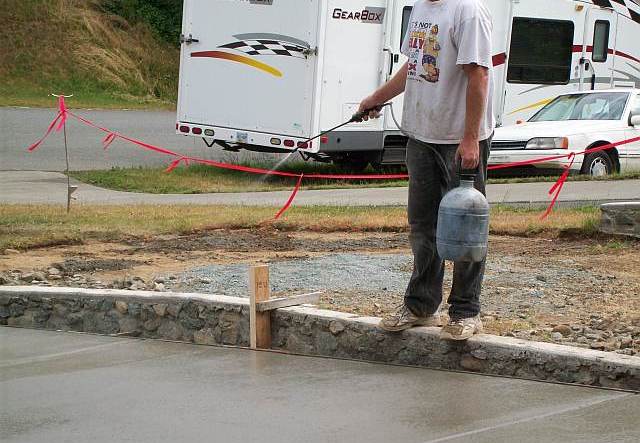
Building Confidence
| Volume 16 Issue 9 ISSN 1923-7162 |

Welcome to Dave's Shop Talk's Home Improvement Newsletter of questions from our members on their construction projects, a Tip of the Month and a home remodeling article, both from our website at http://daveosborne.com.
Tip of the Month
Make a feather board to keep pieces tight against a saw fence when ripping. Also make a push stick to save fingers when ripping narrow pieces on a table saw.
And a Bonus Tip:
When retro fitting a plumbing fixture that requires its own vent, use a mechanical vent.
Ask Dave!
Before Winter sets in with all its fury, check out the following list to keep your home warm, cozy and secure.
Seal up any leaking windows and doors with weatherstrip.
Install plastic over any windows that are not thermopane.
Clean out range hood and bathroom fan filters.
Caulk up any exterior cracks in the siding or stucco where moisture can get in and do its evil deed.
Any outdoor painting should be done before the temperature reaches 50°F (10°C) or below.
Remove all hoses from their hose bibs. Even the frost free hose bibs need to have the garden hose removed so that any water remaining in the valve stem can drain out.
Close all vents to the crawl space. The crawl space should be insulated to prevent pipes from freezing. A small baseboard heater or inline heater, along the pipes, is recommended during this time of year, if temperatures in your area drop below freezing. Secure the heater well to prevent problems.
Basements should be insulated. I recommend constructing a 2x4 wall in front of the concrete foundation wall, floor to ceiling, installing insulation and vapor barrier. Strap and insulate short concrete walls.
Your furnace filters should be changed by now. Cleaning the air ducts is also recommended.
In older homes, check out ways to insulate. Foam pads are available under face plates for plugs and switches. Clear film is made for covering single pane windows. Use caulking to fill gaps around windows, doors and siding.
Check to see if you have fresh air coming into your home in a regulated fashion. Check out the dehumidifier switches for bathroom fans. Forced air furnaces should have fresh air introduced to their cold air return. Talk to local experts who can advise you on this subject. Usually local government departments have free brochures and advice.
Roofs and gutters should be cleaned of moss and debris.
If heating with electricity, check out the possibility of having a ductless heat pump installed. There are now diy units available pre-charged with refrigerant.
Good day. I have a question. I'm installing window casing on the inside of my post and beam house. I am using 4" casing. On 2 of the windows, the rough opening of the window is very close to a log post that tapers towards the bottom to the extent that the 4" casing will not fit as the log tapers somewhat close to the window bottom of the window. Is best practice to cut out the log to accommodate the casing or scribe fit the casing to conform to the tapering of the log?
thanks, dave as well...lol.
I would scribe the casing to fit the log.
Dave
Feature Article of the Month
(taken from our website: DaveOsborne.com)
Concrete Work 1: Exposed Aggregate Driveway
My wife and I recently put in an exposed aggregate driveway. We waited about 19 years, after we built our house, until we got our new driveway. Here are a few tips that I will share with you if you intend to put in a similar driveway.
Exposed aggregate concrete is batched with sand, cement and pea gravel, along with water and the necessary additives. There is no difference in how the concrete is poured but it is not troweled to a smooth finish. After the bullfloat is dragged across it to give it a level and straight surface a retardant is sprayed on to slow down the extreme top layer of the slab from hardening.
This is where the professional guys come in - it is all about timing. When to spray on the retardant or Exposal and when to wash off the cream of the concrete, or laitance to expose the aggregate. To wash too early is to wash the pea gravel away, to wash too late is to not be able to get the laitance off at all.
Some guys seed the top of the concrete with special stones after the placing of the concrete, then trowel them in carefully. In my area, we pour the slab with the pea gravel already in the primary mix. I was going to attempt to try this, being a true do-it-yourselfer, but I'm glad I hired a pro crew, who did an excellent job.
I prepared the surface of the driveway by removing some of the fill near the asphalt pavement at the street, to allow for 4" of concrete. The entire surface, after leveling, was compacted with a rented plate compactor. When the concrete truck backed up the driveway to get close enough to the garage door to spout from the truck, I noticed the tires hardly left any impression in the fill at all. It was a very hard compacted surface, which is very important for any concrete job.
I also drilled out the edge of my existing garage slab at the point of contact with the driveway to install #3 (3/8") rebar between the old and the new concrete. Since my driveway is downhill from the house, I wanted to be sure the driveway slab would not pull away down the slope leaving a gap at the garage door.
I put the rebar in at 12" centers and tied them all together with a long length of rebar. I formed the edges with a slight splay at the street to give a bit more room to turn out. I used 1x4 for the forms and at the splay I cut slots about 1/2" deep every inch apart, on the back side of the 1x4, so that the wood would bend easily.

At the other end of the driveway, the street end, I re-cut the existing pavement to give the guys a clean edge to finish the concrete to.
It worked well.

The finishers put in construction or control joints so that with the expansion and contraction of the concrete any cracks would be formed in the base of these joints and would be less conspicuous.

Below, Rick, the contractor, under the watchful eyes of the boss, is putting in another construction joint. The red flagging tape was to keep the wild deer in our area from walking across the newly poured concrete.

Almost finished. You can see the bull float being used here to smooth the surface of the concrete.

Rick sprays the Exposal or retardant on the wet surface to retard the setting up of the concrete to the top 1/8th inch of the surface.

Rick washes the laitance off carefully, while his helper is sweeping the worst of it off the slab. The young kid dug a hole in the front of our property, at the street, so that the excess cement paste would be trapped in the hole, rather than washing down the street. We washed the street off a while later, as well. Concrete is a messy business.

Here's a photo of our finished driveway.

Thanks, Rick and guys, for a job well done!
Get complete access to our website - Subscribe Now!
We BUILD CONFIDENCE. If you need advice on Building or on your projects at work or home you can make a very small investment and subscribe to our website, then send me any questions or uncertainties you might have via email. There is no extra charge. That is all part of your membership to our site!
Please tell your friends and family about our site and this Newsletter.
Dan and I thank you for your interest and support of our Website!
Your source for building tips, woodworking & furniture plans, house plans and building advice directly from Dave...
Hi, I'm Dave Osborne. With over 50 years experience as a journeyman carpenter, foreman and contractor in heavy construction I enjoyed working with apprentices and sharing the tricks of the trade that others shared with me. Now I get emails from Members all over the world and we include many of my answers in our Free Monthly Newsletters. Some of my answers include drawings and instructions specific to a project, but may also answer your questions. I use correct construction terminology, so you can confidently inform your building supply dealers or contractors exactly what you need.
ASK DAVE!
The Benefits of Membership
Membership gives you full access to our hundreds of how-to articles, woodworking plans, converters, calculators and tables. Our Stair Calculator is one of the most popular on the internet. We have projects you can build for (and with) your kids, furniture for your wife, and sheds and gazebos. If you run into a problem or need advice your Membership includes unlimited email questions to me through our Ask Dave quick response button.
Join us!
Copyright © 1999-2024 DDFM Enterprises. All Rights Reserved. DDFM ENTERPRISES, DAVE'S SHOP TALK and the Dave Osborne logo are trademarks and service marks owned by DDFM Enterprises. All other trademarks on this site are the property of their respective owners. Site design by Design Strategies, Inc.